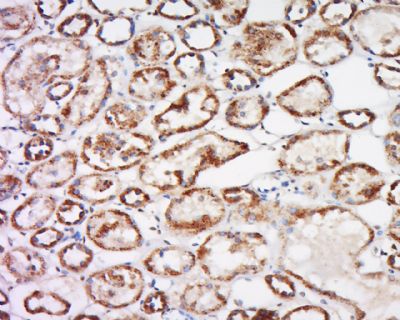Trehalase Polyclonal Antibody
Purified Rabbit Polyclonal Antibody (Pab)
- SPECIFICATION
- CITATIONS
- PROTOCOLS
- BACKGROUND

Application
| WB, IHC-P, IHC-F, IF, ICC, E |
|---|---|
| Primary Accession | O43280 |
| Reactivity | Rat |
| Host | Rabbit |
| Clonality | Polyclonal |
| Calculated MW | 64 KDa |
| Physical State | Liquid |
| Immunogen | KLH conjugated synthetic peptide derived from human Trehalase |
| Epitope Specificity | 81-180/583 |
| Isotype | IgG |
| Purity | affinity purified by Protein A |
| Buffer | 0.01M TBS (pH7.4) with 1% BSA, 0.02% Proclin300 and 50% Glycerol. |
| SUBCELLULAR LOCATION | Cell membrane. |
| SIMILARITY | Sequence similaritiesBelongs to the glycosyl hydrolase 37 family. |
| DISEASE | Note=Deficiency of TREH results in isolated trehalose intolerance that causes gastrointestinal symptoms after ingestion of edible mushrooms. |
| Important Note | This product as supplied is intended for research use only, not for use in human, therapeutic or diagnostic applications. |
| Background Descriptions | Trehalase, also known as TREH, TREA or α,α-trehalose glucohydrolase, is a 583 amino acid protein belonging to the glycosyl hydrolase 37 family. Localizing to cell membrane and lipid-anchor, Trehalase is expressed in kidney, liver, and small intestine. Trehalase hydrolyses ingested trehalose, a disaccharide formed by two glucose molecules found mainly in insects, fungi, and plants, into cellular substrate glucose. Isolated trehalose intolerance due to deficiencies of Trehalase can result in gastrointestinal symptoms. Trehalase may also be a marker for renal tubular damage, and may contain an N-terminal signal peptide, five potential N-glycosylation sites, and a C-terminal hydrophobic region for glycosylphosphatidylinositol (GPI) attachment. Existing as two alternatively spliced isoforms, the gene encoding Trehalase maps to human chromosome 11q23.3. |
| Gene ID | 11181 |
|---|---|
| Other Names | Trehalase, 3.2.1.28, Alpha, alpha-trehalase, Alpha, alpha-trehalose glucohydrolase, TREH (HGNC:12266), TREA |
| Dilution | WB=1:500-2000,IHC-P=1:100-500,IHC-F=1:100-500,ICC=1:100-500,IF=1:100-500,ELISA=1:5000-10000 |
| Storage | Store at -20 ℃ for one year. Avoid repeated freeze/thaw cycles. When reconstituted in sterile pH 7.4 0.01M PBS or diluent of antibody the antibody is stable for at least two weeks at 2-4 ℃. |
| Name | TREH (HGNC:12266) |
|---|---|
| Synonyms | TREA |
| Function | Intestinal trehalase is probably involved in the hydrolysis of ingested trehalose. |
| Cellular Location | Cell membrane {ECO:0000250|UniProtKB:P19813}; Lipid-anchor, GPI-anchor {ECO:0000250|UniProtKB:P19813} |
| Tissue Location | Expressed in kidney, liver and small intestine. Also more weakly expressed in pancreas. |

Thousands of laboratories across the world have published research that depended on the performance of antibodies from Abcepta to advance their research. Check out links to articles that cite our products in major peer-reviewed journals, organized by research category.
info@abcepta.com, and receive a free "I Love Antibodies" mug.
Provided below are standard protocols that you may find useful for product applications.
If you have used an Abcepta product and would like to share how it has performed, please click on the "Submit Review" button and provide the requested information. Our staff will examine and post your review and contact you if needed.
If you have any additional inquiries please email technical services at tech@abcepta.com.













 Foundational characteristics of cancer include proliferation, angiogenesis, migration, evasion of apoptosis, and cellular immortality. Find key markers for these cellular processes and antibodies to detect them.
Foundational characteristics of cancer include proliferation, angiogenesis, migration, evasion of apoptosis, and cellular immortality. Find key markers for these cellular processes and antibodies to detect them. The SUMOplot™ Analysis Program predicts and scores sumoylation sites in your protein. SUMOylation is a post-translational modification involved in various cellular processes, such as nuclear-cytosolic transport, transcriptional regulation, apoptosis, protein stability, response to stress, and progression through the cell cycle.
The SUMOplot™ Analysis Program predicts and scores sumoylation sites in your protein. SUMOylation is a post-translational modification involved in various cellular processes, such as nuclear-cytosolic transport, transcriptional regulation, apoptosis, protein stability, response to stress, and progression through the cell cycle. The Autophagy Receptor Motif Plotter predicts and scores autophagy receptor binding sites in your protein. Identifying proteins connected to this pathway is critical to understanding the role of autophagy in physiological as well as pathological processes such as development, differentiation, neurodegenerative diseases, stress, infection, and cancer.
The Autophagy Receptor Motif Plotter predicts and scores autophagy receptor binding sites in your protein. Identifying proteins connected to this pathway is critical to understanding the role of autophagy in physiological as well as pathological processes such as development, differentiation, neurodegenerative diseases, stress, infection, and cancer.


